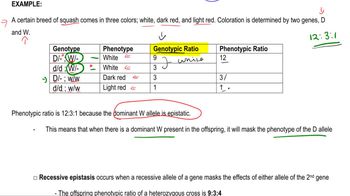In a study of black guinea pigs and white guinea pigs, 100 black animals were crossed with 100 white animals, and each cross was carried to an F₂ generation. In 94 of the crosses, all the F₁ offspring were black and an F₂ ratio of 3 black:1 white was obtained. In the other 6 cases, half of the F₁ animals were black and the other half were white. Why? Predict the results of crossing the black and white F₁ guinea pigs from the 6 exceptional cases.
Table of contents
- 1. Introduction to Genetics51m
- 2. Mendel's Laws of Inheritance3h 37m
- 3. Extensions to Mendelian Inheritance2h 41m
- 4. Genetic Mapping and Linkage2h 28m
- 5. Genetics of Bacteria and Viruses1h 21m
- 6. Chromosomal Variation1h 48m
- 7. DNA and Chromosome Structure56m
- 8. DNA Replication1h 10m
- 9. Mitosis and Meiosis1h 34m
- 10. Transcription1h 0m
- 11. Translation58m
- 12. Gene Regulation in Prokaryotes1h 19m
- 13. Gene Regulation in Eukaryotes44m
- 14. Genetic Control of Development44m
- 15. Genomes and Genomics1h 50m
- 16. Transposable Elements47m
- 17. Mutation, Repair, and Recombination1h 6m
- 18. Molecular Genetic Tools19m
- 19. Cancer Genetics29m
- 20. Quantitative Genetics1h 26m
- 21. Population Genetics50m
- 22. Evolutionary Genetics29m
2. Mendel's Laws of Inheritance
Dihybrid Cross
Problem 17e
Textbook Question
In rats, the following genotypes of two independently assorting autosomal genes determine coat color:

A third gene pair on a separate autosome determines whether or not any color will be produced. The CC and Cc genotypes allow color according to the expression of the A and B alleles. However, the cc genotype results in albino rats regardless of the A and B alleles present. Determine the F₁ phenotypic ratio of the following crosses:
AABbCc×AABbcc
 Verified step by step guidance
Verified step by step guidance1
Identify the genotypes of the parents: AABbCc and AABbcc. Note that the A and B genes determine coat color, while the C gene determines whether color is expressed (C_ allows color, cc results in albino).
Determine the possible gametes for each parent. For AABbCc, the gametes are ABC, ABc, AbC, and Abc. For AABbcc, the gametes are ABc and Abc.
Set up a Punnett square to combine the gametes from both parents. This will allow you to determine the genotypes of the offspring.
Analyze the offspring genotypes to determine their phenotypes. Remember: CC or Cc allows color expression, while cc results in albino. For color, A—B— is gray, A—bb is yellow, aaB— is black, and aabb is cream.
Count the number of offspring for each phenotype and calculate the phenotypic ratio. Include albino as a separate category since cc overrides the A and B genes.
 Verified video answer for a similar problem:
Verified video answer for a similar problem:This video solution was recommended by our tutors as helpful for the problem above
Video duration:
2mPlay a video:
Was this helpful?
Key Concepts
Here are the essential concepts you must grasp in order to answer the question correctly.
Independent Assortment
Independent assortment is a fundamental principle of genetics stating that alleles for different traits segregate independently of one another during gamete formation. This means that the inheritance of one trait will not affect the inheritance of another, allowing for a variety of combinations in offspring. In the context of the question, the A and B genes assort independently from the C gene, which is crucial for determining the phenotypic ratios.
Recommended video:
Guided course

Gamete Genetics and Independent Assortment
Punnett Square
A Punnett square is a diagram used to predict the genotypes and phenotypes of offspring from a genetic cross. It organizes the possible combinations of alleles from each parent, allowing for a visual representation of genetic variation. In this case, the Punnett square helps to determine the phenotypic ratios resulting from the cross between AABbCc and AABbcc, illustrating how different combinations of alleles can lead to various coat colors in rats.
Recommended video:
Guided course

Chi Square Analysis
Epistasis
Epistasis refers to the interaction between genes where the expression of one gene can mask or modify the expression of another gene. In this scenario, the C gene determines whether color will be produced at all, with the cc genotype resulting in albino rats regardless of the A and B alleles. Understanding epistasis is essential for accurately predicting the phenotypic outcomes of the genetic crosses presented in the question.
Recommended video:
Guided course

Epistatic Genes
Related Videos
Related Practice
Textbook Question
511
views


